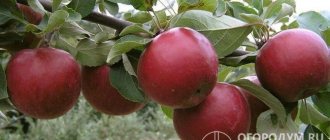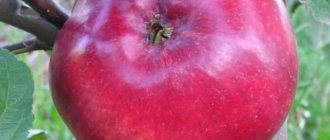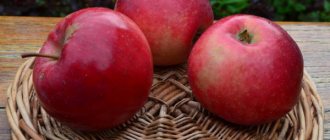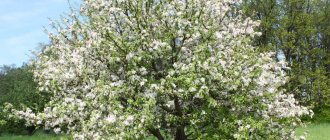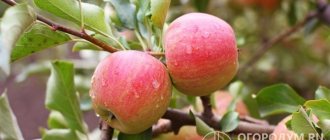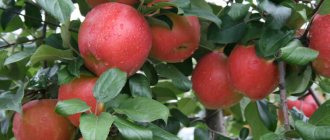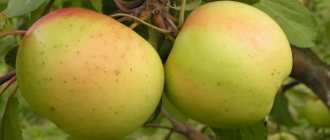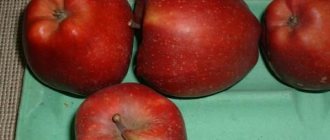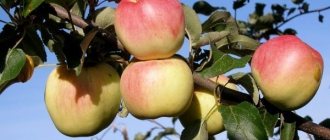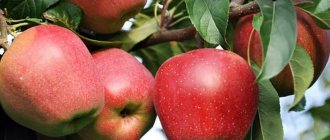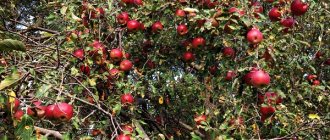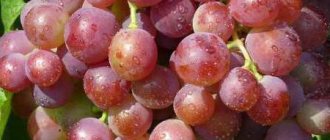Main characteristics
The tree reaches medium size, not exceeding three meters in height. The young individual has a cone-shaped crown. Adult – wide, round and thick. Since the harvest is abundant every year, the branches become drooping. The bark is dark gray in color.
The foliage is oval in shape, wide, stretching towards the tips. It is smooth and has an expressive green tint.
The type of fruiting of this apple tree is mixed. The flowers are moderate in size, saucer-shaped, white with a slight admixture of pink. The stigmas are at the level of the anthers.
The plant does not always cope with severe frosts. Even if the tree survives the winter, the harvest becomes significantly smaller, and its quantity is significantly reduced. Experts advise planting the variety in regions where winter is not too harsh.
Delicious apple tree: growing in the regions
The Delicious apple tree likes to grow in a dry climate, and also to keep the air temperature warm during the day and cool at night. That is why this fruit tree will be an excellent option for growing in the Moscow region and in the central zone of our country. Growing in such regions, the crop will feel excellent and produce a good and tasty harvest of ripe fruits. When cultivating this variety in Siberia, it is worth taking quite serious care to protect it from strong, gusty winds and frosts, for which purpose it is given additional shelter starting from the autumn period, for the winter period, and before the arrival of warm weather. This is due to the fact that spring frosts are more dangerous and destructive for this tree than stable cold weather.
Description of fruits
The fruits are medium or large, have a round-conical shape. The skin is quite dense, slightly rough to the touch. Weight depends on the region where Golen Delicious grows. In the South you can achieve an apple weighing up to 170 grams, but in other places the weight will be lower.
The color of the crop is initially light green, but then it turns golden, with slight brown pigmentation possible. If ripening occurs on the sunny side, a characteristic blush may appear.
The pulp is white, quite dense, and during storage can change color to cream or light yellow. The taste is rich and bright, more dessert-like. The sugar content in apples is about 20%.
As for the keeping quality of the crop, it depends on the specific storage location. Under properly organized conditions, apples can be kept from the end of September until about March. But if the air in the storage is very dry, the fruits may spoil. The temperature of the room where the crop is located must be maintained at a level of 0 to +4 degrees, humidity 85-90%.
You can eat apples both fresh and processed. They make good compotes, marmalade, jams, and so on.
Subspecies and options
The variety has become so popular that it has many varieties and clones . Of these, Golden Delicious and Golden Rangers are especially interesting; Golden Vladimirsky is worth considering separately.
Delicious
The Golden Delicious apple tree is a medium-ripening . Actually, this is the true Golden . Apples begin to be harvested in mid to late September. High yields were noted. Seven-year-old trees can produce up to 250 - 300 c/ha.
Fruiting occurs only in the second or third year after budding. Fruits are formed on the second year's growths and on last year's branches.
The shoots of this apple tree variety are slightly elbowed, have a slightly curved shape, and are of average thickness. The leaves are oval, glossy, rich green. The veins are clearly visible.
The flowers are round, slightly concave, white in color with a barely noticeable pinkish tint.
The Golden Delicious apple tree variety is self-sterile , so it requires pollinators . The following varieties are very good for pollination:
- Melrose;
- Idared;
- Jonathan.
Idared.
The fruits are slightly elongated, smooth, and medium in size. On average, the weight of each fruit reaches 220 g.
Apples range from light green to golden yellow, depending on ripeness. Sometimes the fruits have a pinkish blush on the southern side of the growth. A striking distinctive feature of the variety are small dark dots throughout the fruit.
The fruits are juicy, sweet , and have a pronounced apple aroma. When stored, the fruits taste even more pleasant.
Golden Delicious fruits.
Golden is perfectly stored from the time of collection until March, or even April.
Attention! If stored improperly, a slight lethargy of the fruit and loss of juiciness may be noticed, but the taste is not particularly affected.
Watch a short video review of the Golden Delicious apple tree:
Rangers
Golden Rangers is considered a clone of Golden Delicious , its mutation is considered a very promising clone.
The ripening period for Rangers is winter . The tree is slightly taller than Golden Delicious and develops from medium size to vigorous growth.
Young trees have a cone-shaped crown , but at the time of fruiting the crown becomes rounded and of medium density.
The fruits are slightly elongated and can be either round or cone-shaped. The color is yellowish-green.
The fruits also have dots . Unlike the Golden Delicious variety, these fruits are not rusty , which gives them a more pleasant appearance.
The taste of the fruit is very high. Juicy, sweet, with a strong aroma.
Fruits of Golden Rangers.
Characterized by stability of fruiting . The harvest begins in late September and ends in mid-October.
High transportability and long shelf life are noted If all storage rules are followed, apples can be preserved until April ; under normal conditions, they retain their taste until February.
Important! The variety is frost-resistant and tolerates drought well.
Vladimirsky
The Golden Vladimir apple tree is considered by some gardeners to be a variety of the Golden Delicious variety.
However, this variety was bred in 1984 in the Vladimir region (where the name of the variety comes from) from the common Antonovka , which was pollinated by the American form . The latter brought immunity to scab.
The fruits actually resemble Godin Delicious apples in appearance. They have a color from greenish to yellow, blush is possible.
The taste is very good - the fruits are sweet, there is no blandness, they can be used even without ripening, immediately after being picked from the branch.
They have a strong apple aroma. The flesh is dense, juicy, and breaks off when bitten. The fruit size reaches 220 g.
Fruits of the Golden Vladimirsky apple tree.
It is distinguished by stable, annual fruiting.
ATTENTION! The developed variety has high frost resistance, which makes it possible to grow it in our climatic conditions without any difficulties.
However, it should be noted that this variety is quite rare.
You can watch a review of this variety in the video below:
Other varieties
The Golden variety has become the basis for columnar apple trees. A striking example of this is Golden Sentinel . This is a fast-growing variety with autumn ripening.
Sentinel apples have a greenish color, the weight of each fruit reaches 200 g. Very sweet, with a pronounced aroma.
Golden Sentinel.
Also interesting is the dwarf Golden apple tree, whose height does not exceed 2-3 meters in adulthood. However, growth does not at all affect the taste of the fruit, and the size of the apples does not differ from ordinary ones .
The Golden Delicious Smoothie variety is in particular demand . This is a winter variety, it is more resistant to diseases, and fruiting is more productive than Golden. This variety occupies one of the first places in the world in sales, as the fruits are perfectly stored, have increased transportability and excellent taste.
Golden Delicious Smoothie.
A very promising and bright variety Red Golden Delicious . It has the same wonderful qualities as the main variety, but differs in the color of the fruits - they are red.
Red Golden Delicious.
You can see what a Red Golden Delicious apple tree with fruits looks like in the video below:
Pollinator trees
An apple tree of this variety needs to be placed nearby pollinators. The following varieties are suitable:
- Kuban spur;
- Melrose;
- Jonathan;
- Idared;
- Delicious spur;
- Wagner prize money.
Kuban spur
Melrose
Jonathan
Idared
Productivity
Fruit ripening period is average. Harvesting occurs once a year, usually in mid to late September. The fruits can be harvested for the first time in the second year after planting.
The tree produces up to 80 kilograms of apples. During the first 7 years of life, the variety pleases with a good harvest, but in the future it depends on the weather and climate characteristic of the region. At 10 years old, you can get up to 300 centners of apples per hectare (up to 120 kilograms per tree).
Description of the variety and its characteristics
This type of apple tree came to us from Europe, and there from America. The variety turned out completely by accident, as no one can give a specific answer to this question. An apple tree of an unknown variety was discovered in one garden in the country and grown. The taste and appearance of the fruit were pleasantly surprising, and the variety quickly gained immense popularity in many countries.
Description of the tree
The trees of this variety are beautiful in appearance and can decorate any garden plot with dignity:
- Medium-sized apple trees are compact. They are distinguished by a beautiful cone-shaped crown;
- the trees are covered with a large number of large bright green glossy leaves, shaped like a boat, slightly covered with fluff;
- The variety begins to bear fruit early - already in the second year after planting the first apples appear;
- Fruiting of apple trees is periodic, that is, they do not produce harvests every year;
- flowers - medium in size, numerous white;
- flowering occurs late - in late May-early June and lasts about 2 weeks;
- the Golden Delicious variety requires other varieties for pollination, such as Melrose, Renet Simirenko or Idared;
- Many different hybrids have been created from trees of this variety.
Description of fruits
Fruits of this type are just a sight for sore eyes:
- large, weighing up to 180 g, they have a beautiful oval shape and a bright yellow color with speckles;
- sometimes a soft pink blush may appear on the apples;
- tender and very juicy pulp covered with thick skin;
- it has a rich sweet taste, similar to caramel, and an unsurpassed aroma.
100 g of pulp contains:
- sugars - about 13.5%;
- acids - 0.4%;
- vitamin C - about 12 mg;
- pectin - 0.7 mg;
- dry ingredients - about 20%.
On a five-point scale, taste is rated at 4.7 points.
Usage
Golden Delicious fruits are used to make preserves, jellies, jams, confitures, compotes and purees. They are dried, added to fruit salads and fillings, and the juice made from this variety of apples has an unsurpassed taste and aroma.
Ripening and harvesting dates
The Golden Delicious apple tree is a late variety that ripens in mid to late September. Then they begin the massive harvest.
Read also: Is it possible to eat sick broilers?
Productivity
The productivity of the variety is very high. Sometimes so many apples grow on tree branches that they cannot withstand such a quantity and break. Trees begin to bear fruit at full strength in 5-7 years. From one tree you can collect up to 120 kg of selected apples, and from one hectare - up to 300 centners.
Shelf life and transportability
Apple varieties have a long shelf life. Under certain conditions, they can be stored until April. At the same time, they not only retain their excellent taste and beautiful appearance, but also become even tastier and sweeter.
Apples of this variety are very popular among farmers who are happy to grow them on a commercial scale.
Advantages and disadvantages
Let's look at the strengths of this variety:
- good yield;
- fruiting occurs early;
- ripe fruits do not fall off;
- the apple tree tolerates winter in regions with warm or temperate climates;
- the presentation is preserved for a very long time, the shelf life is long;
- the harvest is not afraid of transportation;
- apples are suitable for consumption in various forms.
And now a little about the weaknesses:
- without pruning, the fruits become smaller;
- the variety is afraid of drought;
- the harvest may be periodic;
- the plant is not immune to brown spot and powdery mildew;
- fruits wilt if there is insufficient humidity in the storage room.
Gardeners of different latitudes
Not only residents of warm regions, but also gardeners in the Urals, Moscow region and in the north-west of Russia want to have such a bright variety as Golden.
But if in the Volga region, Ukraine and Belarus the climate does not present frosty surprises, then residents of cooler areas will have to be more careful when growing this apple tree. Although the Golden Delicious apple tree is quite common in the Moscow region.
Golden Delicious prefers warm climates.
Golden is a heat-loving variety , but many species of this variety have already been bred that can perform excellently in severe climatic conditions (Golden Rangers). These varieties are no worse than the basic ones, and in terms of resistance to frost they show themselves to be much more hardy.
Gardeners in warm regions should not be afraid of frost, but they should closely monitor the moisture of the soil, because high temperatures in the summer can quickly dry out the soil, which young plants cannot tolerate.
Diseases and pests
This variety suffers most from powdery mildew and brown spot. If you detect a problem in time and take action immediately, there will be no special consequences. If you ignore the disease, the harvest will be noticeably reduced or completely lost.
Characteristic diseases and control methods
- Powdery mildew. It manifests itself as a white coating, noticeable on leaves or inflorescences, sometimes on shoots. Treated with the preparations “Topaz”, “Skor”, 1% suspension of colloidal sulfur.
- Brown spot . Spots of light shades with a brown border. For treatment, 1% Bordeaux mixture, the drugs “Captan” and “Zineb” are used. For prevention, it is necessary to dig up the soil before winter, as well as maintain soil moisture at a moderate level.
- Scab . It has symptoms such as a brown coating on the foliage, flowing into black spots and cracks. For treatment, 1% copper sulfate and the preparations “Skor” and “Hom” are used. Treatments are carried out before the leaves bloom, after flowering, 20 days after previous activities and 15 days before harvesting the fruits (if necessary). If you need to treat a tree before buds open, use an infusion of horsetail (pour a third of a bucket of the green part of the plant with 10 liters of water and let it brew for 3 days). As a preventative measure, it is advisable to carry out sanitary pruning of branches and adequate fertilizing.
- Premature leaf drop . Reset of leaves after a long drought. For treatment (10 days after flowering) use 0.2% magnesium sulfate. You need to do 3 sprayings, maintaining an interval of 2 weeks.
Powdery mildew
Brown spot
Scab
Premature leaf drop
Pests and control methods
- The leaf roller attacks foliage, inflorescences, apples and buds. Treatment should be carried out early in the spring, using 3% Nitrafen, preparations “Atom”, “Zolon”, “Ditox”. For prevention, before the buds open, you need to spray with the drug “Profilaktin”.
- Green aphids cause leaf curling and shoot tips to dry out. Until the buds open, the apple tree is treated with Karbofos at the rate of 90 grams per 10 liters of water; during bud break, the preparations “Cyanox”, “Metaphos” are recommended, as well as a soap solution at the rate of 200 grams of laundry soap per 10 liters of water. For prevention, it is recommended to burn the leaves.
- The apple mite entangles the foliage with a web. The tree is treated until the buds open, and if necessary, manipulations can be continued after flowering is complete. Use 10% Karbofos or chamomile infusion. For prevention, it is recommended to peel off the old bark and also burn fallen leaves in a timely manner.
- The apple flower beetle eats buds, stamens and pistils. Treatment is carried out before flowering with Fufanon (10 milliliters per 10 liters of water) or with Inta-Ts-M (tablet per bucket of water). For prevention, you need to remove the bark from the lower branches and trunk, and also use catching belts.
leaf roller
Green aphid
Apple mite
Apple flower beetle
Features of the variety
It is quite easy to recognize apples of this variety in the garden by the characteristic features that are unique to Delicious.
Brief history of origin, where they grow
There is no exact information about how Delicious was developed. According to assumptions, the apple tree variety was formed as a result of random pollination of different varieties and the process of mutation. The birthplace of apples with amazing taste is Southern Virginia (America).
Characteristics of trees, shoots, foliage, fruits
The shape of the tree changes depending on the stages of life. The young plant resembles an inverted pyramid in appearance; during the fruiting period it becomes rounded. The apple tree develops intensively, growing branches from the trunk at an acute angle. Near the base the shoots bend slightly. The bark is dark gray, medium thickness. The Delicious variety has mixed fruiting. Fruit twigs and spears predominate.
Brief description of the escapes:
- dark red shade;
- length and thickness are average;
- there is a weak edge;
- There are small lentils along the entire length (in the part located closer to the base, they are located in groups);
- the bends are moderately geniculate.
The leaves have a broad oval shape; occasionally there are trees with oblong-ovate greenery. The edges are framed with a double-tooth cut. There is a slight bend in the plate. The foliage color is dark green with a transition to a light tone closer to the petiole. The edge is barely noticeable.
The surface of the plate is low gloss. The long petiole towards the base or along the entire length is colored red. Stipules are lanceolate of medium size.
The inflorescences are characterized by large parameters, the shape resembles a bowl, the color of the petals is pink. The buds themselves are red. A column of pistils is visible in the center. They are long with edges. The stigmas are located at the level of the anthers or below them.
Description of fruits:
- sizes (with proper care) – large;
- shape – oblong-conical, ribbing visible;
- there are 5 distinct tubercles around the saucer;
- the diameters of the apple change along the entire length, especially in the lower part;
- the skin is dense, smooth, there are subcutaneous white dots and gray protrusions on the surface;
- the color of the fruit is light green (as it reaches full ripeness the color turns yellow), Red Delicious apples are a rich dark red color;
- the pulp is white with a green tint (it turns yellow during storage), the structure is dense;
- taste qualities - pleasant aroma, sweet note with barely noticeable sourness, a lot of juice.
Reference! The result of improper care of the apple tree is an altered taste, which becomes fresh and bitter. Fruits rarely fill to standard sizes.
Apples are picked from the tree at the end of September. When favorable conditions are created, the harvest is stored until March and even April. The yield per 1 ha is 130-190 centners. Fruiting is periodic with mild variability.
The weak point of the variety is considered to be a tendency to scab.
Composition and beneficial properties of fruits
Despite the fact that the fruit consists primarily of water (more than 50%), it contains a large number of chemical elements valuable for the human body. Among them:
- potassium;
- magnesium;
- iron;
- phosphorus;
- sodium;
- manganese;
- fluorine;
- zinc, etc.
In addition, the pulp is saturated with vitamins of different groups: C, A, PP, B9, B6, B5. Carotene, which is part of the fruit, has a beneficial effect on nails and hair, visual function and bone tissue. Ascorbic acid helps strengthen the protective function, which helps resist viruses and infections. Iodine improves thyroid function.
| Composition of Delicious apples | |
| Name | Volume per 100 g |
| Ascorbic acid | 5.2-10.0 mg |
| P-active substances | 140 mg |
| Pectins | 0.7 mg dry weight |
| Sugar | 11-13% |
| Titratable acids | 0,25% |
Regular inclusion of apples in the menu helps reduce cholesterol in the blood. This prevents the development of vein blockage, helps cleanse blood vessels, and has a beneficial effect on the functionality of the cardiovascular system. The beneficial properties of the fruit remain for a long time.
Reference! Antioxidants entering the body with an apple stimulate blood flow to the gums. Malic acid has a destructive effect on dental plaque.
Doctors advise including the product in any form on the menu for diseases of the kidneys, liver and heart. The high fiber content helps cleanse the intestines of toxins and waste products. Iron normalizes blood hemoglobin levels. Apple tea is good for relieving nervous tension.
Taste qualities
The incredible aroma is combined with the sweet taste of the pulp. The dense structure does not cause discomfort when eating the fruit due to the increased juice content. A special feature of the variety is the fact that as apples are stored, their taste characteristics only improve.
Landing
The most important thing here is to choose a good seedling. A healthy young plant should have a beautiful trunk, branches and roots without any signs of disease, and the root system should be moderately developed, and the number of skeletal branches should be 3-4 (for a three-year-old tree). An annual apple tree does not have branches, so you will have to do the formation of the crown yourself.
As for the planting location, high places in the sun where the groundwater runs deep enough are best. The apple tree loves light loamy or soddy-carbonate soils.
In warm areas, you can plant a tree in the fall, in October. The pit is prepared a month in advance: a hole is formed one meter deep and one meter wide, maintaining a distance of 3 meters between individuals. Then apply fertilizer consisting of 2 buckets of humus, 2 kilograms of superphosphate, 150 grams of potassium sulfate and a kilogram of wood ash + fertile soil layer.
Step-by-step instructions for planting trees:
- Soak the roots of the young tree in water for 6-12 hours.
- Place a peg in the hole.
- Position the young plant so that the root collar is 5 centimeters above the ground level.
- Hold the seedling and fill the hole with soil.
- Tie the apple tree to a peg.
- Add a couple of buckets of water. Then water once every 3 days (3 buckets).
- Mulch with humus.
Care
Caring for an apple tree is not that difficult. Particular attention should be paid to watering. It is first carried out before the buds open, then 3 weeks after flowering, then 3 weeks before harvesting, and the last time when the leaves fall. You need 5 buckets per tree. If the summer is dry, you can increase the amount of watering.
It is recommended to cover young plants with spruce branches for the winter. Also, for the first couple of years you need to constantly get rid of weeds.
Terms of flowering, fruiting and storage of apples
Delicious blooms in late May - early June. The flowering period is long. You can see pink inflorescences on planted seedlings, but the tree will only be able to bear fruits after 2-3 seasons.
Fruiting begins in the second ten days of September. The harvesting process lasts until the end of the month. Each fruit should be carefully inspected before being sent for storage. For long-term maintenance of apples, only those that do not show signs of disease or damage are selected. The presence of a stalk is welcome.
Fruits with dents, wounds and other damage are immediately sent for processing. They are not suitable for storage.
The harvest is kept in a cellar or other utility room where a stable temperature range of 0 +4 degrees is established. In this case, the humidity indicator should be within 85-90%. Dry air causes apples to wilt.
Apples of different varieties are stored in separate containers. Fruits should be placed in boxes in one or a maximum of 4 layers. To prevent the spread of rot, it is recommended to wrap each fruit in newspaper or wrapping paper. Paper sheets are also placed between the layers.
Feeding
The plant needs regular feeding. Per square meter use 200 grams of wood or leaf ash. Liquid fertilizers are also needed, which are applied at the end of June. For this, slurry diluted 3 times or bird droppings diluted 10 times is suitable. Mineral fertilizers (sodium, phosphorus, potassium) are applied at the rate of 20:30:15 grams per 10 liters of water.
Please note: all fertilizing is carried out after good rains or abundant watering, so as not to burn the root system.
Apple tree Golden
There is no exact information about how this variety was obtained; it is believed that it was formed by accidental pollination or as a result of mutation . It is only known that the birthplace of this amazing apple tree is Southern Virginia.
Gardeners note the obvious advantages of this variety:
- Excellent taste;
- High yield;
- Commercial appearance;
- Excellent transportability;
- Preservation of taste with long shelf life.
Golden fruits tolerate transportation well.
There are also disadvantages:
- Susceptibility to powdery mildew;
- With age, annual fruiting is disrupted;
- Good fruit size requires good conditions;
- Does not withstand severe frosts.
Trimming
In April, frozen branches are cut off and the crown is formed. After the leaves fall, sanitary pruning is carried out. All cutting areas are treated with garden varnish, and the cut branches are burned outside the site.
At 3 years old, one-year-old branches are cut by a quarter, and at 5 years old branches are cut off by a third of their length.
Reviews
Alena, Noginsk : We have been growing Golden Delicious for a long time, we are very happy. Children especially like sugar apples. We eat it calmly all winter, the harvest does not lose its taste. Sometimes only the tree freezes if the winter is too harsh.
Valery, Shatura : I tried apples of this variety from a neighbor a long time ago and immediately planted several trees at home. The fruits are simply incredible - very sweet, tasty, ideal in the form of jam. And the variety’s yield is very good; we don’t even always eat it ourselves – we share it with friends.
History of the Golden Delicious variety
As paradoxical as it may sound, no one has bred one of the most famous varieties of apples in the world. The apple tree, later named Golden Delicious, was discovered completely by accident. In the American state of Southern Virginia in 1890, Anderson Mullins noticed a productive tree with tasty fruits. The plot with the apple tree growing on it was bought by a small horticultural company, which subsequently introduced this plant, multiplying and planting seedlings of the variety in its fields. Other producers paid attention to the apples, and Golden Delicious began its march through the orchards of the world. The first seedlings came to Russia in the 20s of the last century, but the variety received official recognition only in 1965, when it was zoned for the North Caucasus region .
In 2021, Golden Delicious is offered for cultivation in the Kaliningrad region.
